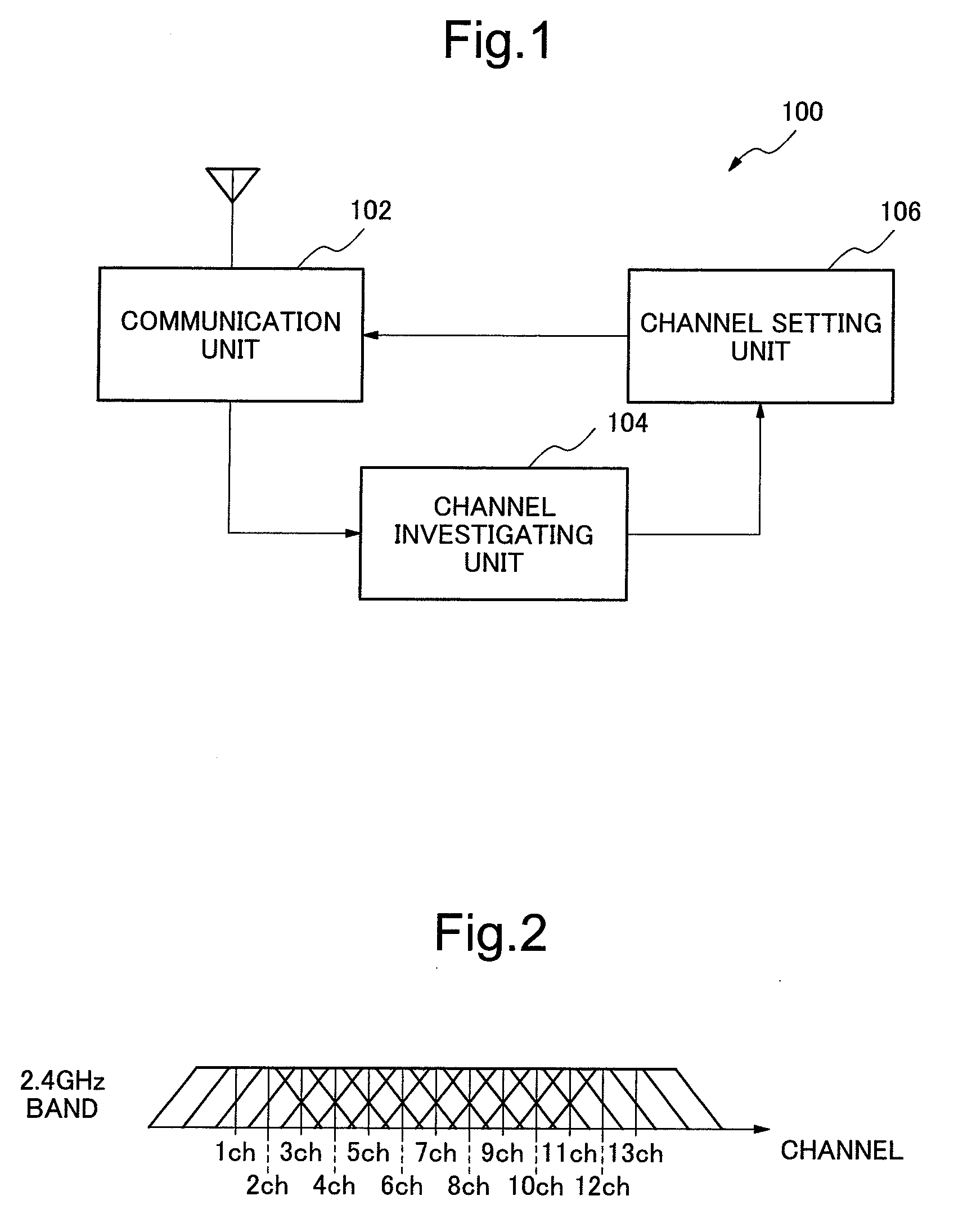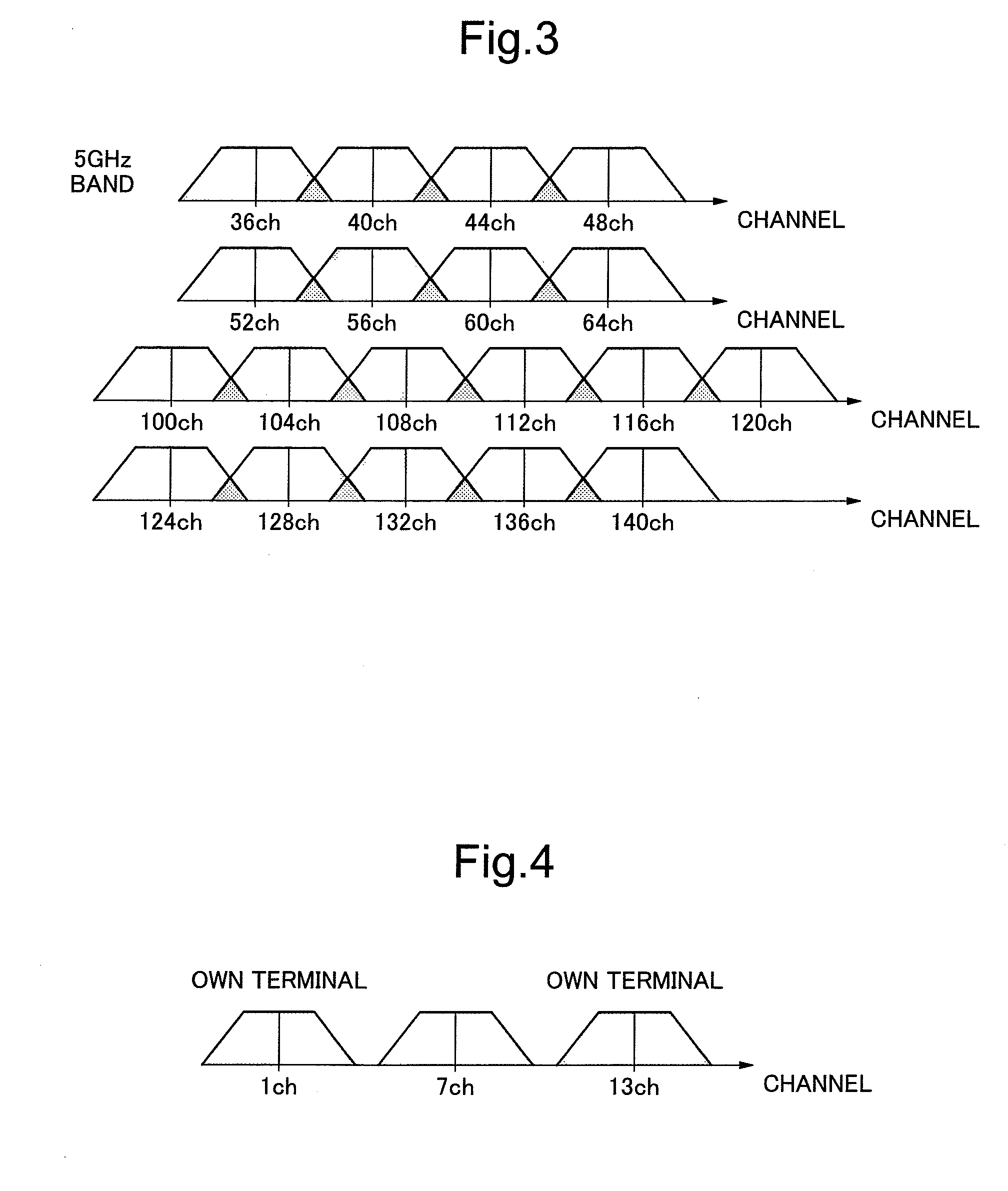Radio communication terminal, method for selecting communication channel and computer-readable storage medium
a radio communication terminal and computer-readable technology, applied in the field of radio communication terminals, can solve problems such as degrading throughput due to mutual interference, and achieve the effects of low-level radio-wave interference, high-speed data communication, and high quality
- Summary
- Abstract
- Description
- Claims
- Application Information
AI Technical Summary
Benefits of technology
Problems solved by technology
Method used
Image
Examples
first embodiment
[0029]FIG. 1 is a block diagram showing a radio communication terminal 100 which is an example of a configuration of a first embodiment according to the present invention. The radio communication terminal 100 includes a communication unit 102, a channel investigating unit 104 and a channel setting unit 106. The communication unit 102 performs communication using at least one channel in a first frequency band (for example, either 2.4 GHz band or 5 GHz band).
[0030]The channel investigating unit 104 investigates all channels in the first frequency band, detects an available channel or channels in all the channels and outputs the detected result as available channel information.
[0031]On reception of the available channel information, the channel setting unit 106 determines whether or not a plurality of adjacent channels are available for communication in the first frequency band based on the available channel information. When it is determined that the plurality of adjacent channels are...
second embodiment
[0053]FIG. 6 is a block diagram showing a radio communication terminal 200 which is an example of a configuration of a second embodiment according to the present invention. The radio communication terminal 200 includes a communication unit 202, a channel investigating unit 204 and a channel setting unit 206. The communication unit 202 can perform communication by using least one channel in a second frequency band in addition to the first frequency band.
[0054]The channel investigating unit 204 investigates all channels in the first and the second frequency bands, detects an available channel in each of the first and the second frequency bands and outputs the detection result as available channel information. Further, when no available channel is detected, the channel investigating unit 204 outputs the number of at least one channel having a low noise level among the channels as the available channel information.
[0055]The channel setting unit 206 receives the available channel informa...
third embodiment
[0078]FIG. 11 is a block diagram showing a radio communication terminal 300 which is an example of a configuration of a third embodiment according to the present invention. The radio communication terminal 300 includes a CPU (Central Processing Unit) 301, a communication control unit 302, an antenna 303, a radio wave state analyzing unit 304, an operation and display unit 305, a RAM (Random Access Memory) 306 and a ROM (Read Only Memory) 307.
[0079]CPU 301 controls the whole of the radio communication terminal 300. The communication control unit 302 controls wireless communication in a first frequency band (for example, 2.4 GHz band) and a second frequency band (for example, 5 GHz band). The antenna 303 sends and receives a radio wave. The radio wave state analyzing unit 304 analyzes data obtained through channel search and a channel monitor and checks a state of a surrounding radio wave such as a noise level. The operation and display unit 305 is handled by a user and displays requi...
PUM
 Login to View More
Login to View More Abstract
Description
Claims
Application Information
 Login to View More
Login to View More - R&D
- Intellectual Property
- Life Sciences
- Materials
- Tech Scout
- Unparalleled Data Quality
- Higher Quality Content
- 60% Fewer Hallucinations
Browse by: Latest US Patents, China's latest patents, Technical Efficacy Thesaurus, Application Domain, Technology Topic, Popular Technical Reports.
© 2025 PatSnap. All rights reserved.Legal|Privacy policy|Modern Slavery Act Transparency Statement|Sitemap|About US| Contact US: help@patsnap.com



